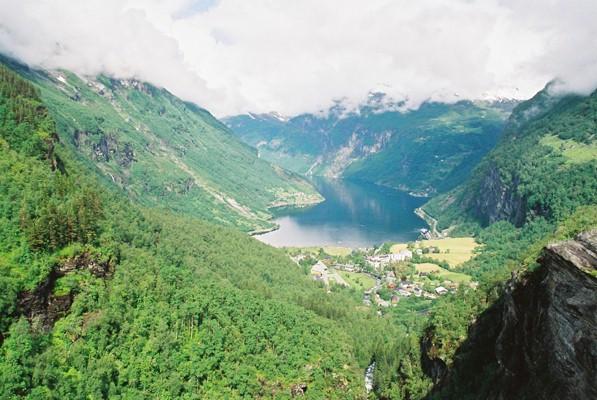
Stretching towards the very top of the world, the beautiful Scandinavian haven of Norway is best known for oil, a penchant for fish, the home of the Vikings, scarily high prices, the composer Edvard Greig and, of course, those fantastic fjords and stunning scenery. With a population of less than 5 million and an area of nearly 3 times the size of Great Britain, it is hardly what you would call crowded. Much of the northern portion of the country lies within the Arctic Circle, but our destination was Bergen, the gateway to the majestic Norwegian Fjords.

Getting there was simplicity itself. We sailed on the overnight DFDS Ferry, direct from Newcastle to Bergen, via Stavanger and Haugesund. Taking 28 hours in total, the ferry is more of a mini cruise than a ferry crossing, which is certainly backed up by the facilities on board the MS Queen of Scandinavia, including two restaurants, nightclub, numerous shops and coffee bar, cinema, swimming pool and sauna. There were a surprising number of bikes checking in for the ferry, which as well as touring Brits, included a large number of Norwegians and other Scandinavians returning from the IoM TT races the week before.
The ferry dropped off at Stavanger and Haugesund before Bergen so we watched quite a few Harley's unload and join a large escorted tour whilst downing the last of our agreed quota of apple and pear ciders.
The ferry docked at Bergen at 23:00 on Sunday 8th June, after a very calm North Sea crossing, and our first nights accommodation in Norway was at the Clarion Hotel at Bergen airport, some 20 miles south of the ferry terminal, along the 580. Easy enough to find and in relative daylight, as this far north, in summer, it never really gets dark. We filled up just after leaving the ferry as there were no petrol stations between the Tyne Tunnel and the ferry port on the way and knowing we could get lost it seemed wise to have a full tank. A lot of the petrol stations in Norway are unmanned, particularly at night, with card payment pumps and there was a mild panic when it ate the card and gave no instructions what to press. We worked out ‘enter pin’ and got the rest by deduction (pin and then klar if you need to know), every pump after that one stated (mostly in English) what to do quite clearly so we were just unlucky.
The following morning, we retraced our route into Bergen, which is a relatively busy city, where we picked up the E39 to head north. One bridge and seven tunnels later, we arrived at the ferry terminal at Ytre Oppedal to cross the Sogne fjord. In the Fjords region of Norway, there are numerous ferry crossings where the road just stops, then picks up again at the other side of the water. Cheap for bikes to cross and they are literally ride on and ride off and run constantly. Once across the Fjord, the E39 hugs the shore for a number of miles, before heading inland to our destination of Forde. Some twenty miles from Forde, the weather turned and it started raining heavily, setting the theme for just about the rest of the tour and making much of the fantastic views misty and grey. As we checked in to our hotel, we were told the prior week had been fantastically sunny and what a shame it was to be raining. We had travelled a mere 106 miles from Bergen but with winding roads and a rigidly enforced speed limit of 70 KPH, it still took a good few hours. Besides, with stunning scenery to look at, there is no inclination to rush. Forde is a modern little town with a biggish shopping arcade, but fairly nondescript and other than the river bridge, not much to look at.
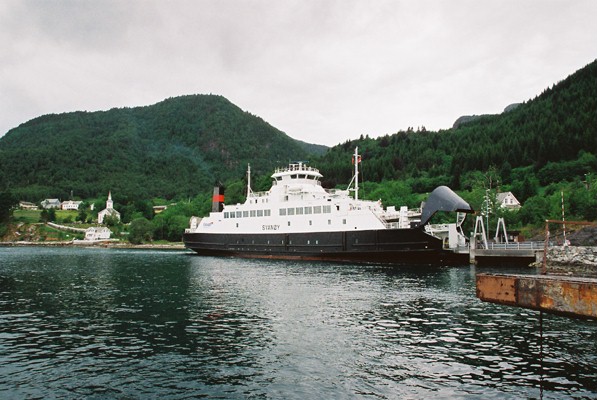
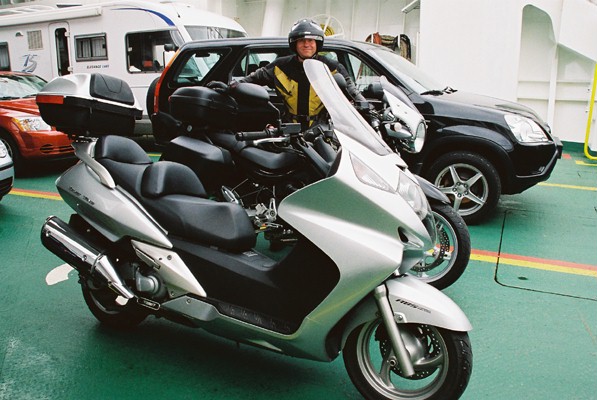
Day 4 saw us again on the E39, heading north towards Alesund, passing numerous small Fjords and taking in 3 ferry crossings, Anda to Lote, Folkestad to Volda and Festoya to Solevag. Beware of being parked in the middle of the ferry at either side, as after heavy rain, when the ferry docks at the landing and lifts, it can deposit a surprisingly large amount of water right where you are stood!!! However, this broke the ice with some of bikers from Finland we had followed for much of the route, but as their English was a bit limited and our Finnish completely non-existent, communication was restricted to numerous grins and nods. Ten miles outside Alesund, we left the E39, and followed the E136 into town and to our hotel for the night, having travelled 125 miles from Forde. The scenery we had passed through was stunning and with the brightly coloured wooden houses, you could almost be in the White Mountains of New Hampshire, in the good old US of A. Alesund is at the end of a peninsular and is a maritime town, home to one of the largest and most important fishing ports in Norway. It is also a most attractive town, with many fine old buildings, barring the odd 1970's concrete monstrosity.
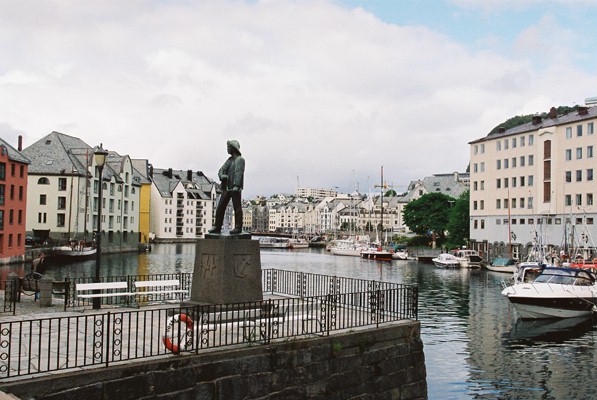
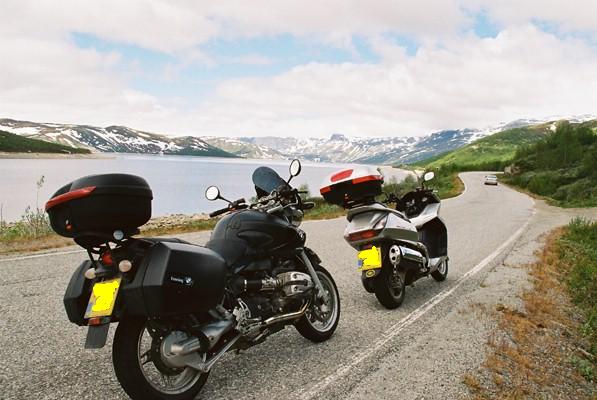
Day 5 saw an early start, not because of the distance we had to travel, but because the hotel didn't have it's own parking and we were parked overnight on parking meters (free from 16:00 to 09:00) and we didn't want to incur the wrath of the local parking mafia. From Alesund, we took the E136 East, a lovely winding road past numerous Fjords and breathtaking scenery to Sjoholt, where we picked up the smaller route 650, heading south. We stayed on the 650 for about 24 miles, before picking up the 63 at Linge, and a ferry across Norddals Fjord. Once across the fjord, the road rose sharply into the mountains, giving some stunning views. After crossing the Blafjell mountain pass, where the temperature noticeably dropped, the 63 begins it's sharp descent to Geiranger. The view to Geiranger from the mountain behind the town must be one of the most well-known country-side views in the world. Often taken with cruise ships anchored just off the end of the fjord, the scene portrays the near vertical cliffs, which drop huge distances to the water. It is a breathtaking view and Geiranger Fjord is often claimed to be the most beautiful of all of Norway's many fjords. The 63 into Geiranger is known as Eagle pass and includes a dozen hairpin bends within the space of a mile or so. Visibility was limited due to the heavy rain and misted up visors, so this last section of road is best described as 'interesting'. As we checked in to our hotel we were told the prior week had been fantastically sunny and what a shame it was to be raining, again.
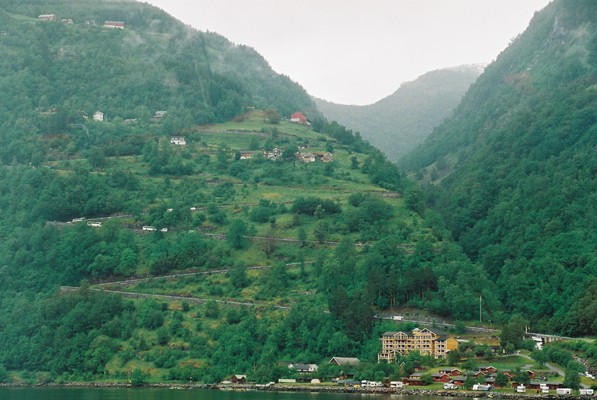
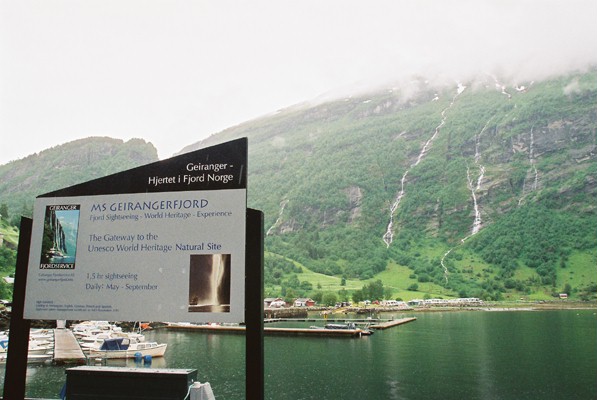
The area is famous for it's mythical trolls, and there are plenty of opportunities to buy one, in several varieties and sizes, in the many gift shops that cater for the cruise ships. The following day we had a day off from the bikes and took the sightseeing tour boat to see more of Geirangerfjord. You can only really see the best of the fjord by boat as the sheer cliff sides preclude any possibility of a road or track. Spectacular is the only way to describe it. Among the dozens of waterfalls, there are a number of abandoned farm houses located in the cliffs, some of which were occupied right until the 1960's. Although abandoned for many years, they have been restored and are maintained by a local trust, to preserve the heritage of this unique area. Some of these were only accessible by ladder and the best story is about the farmer who pulled up the cliff ladder to prevent the tax man from getting to him!
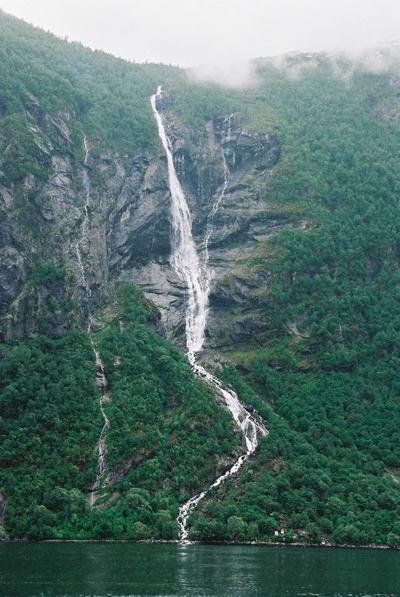
In addition to the tour boat, you can also see much of the fjord by taking the ferry to Hellesylt. Cheaper than the sightseeing boat, but you don't get the running commentary. Whilst we were at Geiranger, the QE2 visited which is a sight to behold in itself, as it made the other two cruise ships there at the time look like it's own lifeboats. The QE2 is absolutely colossal and seeing it being turned round by two pilot boats, with not a huge amount of clearance fore and aft, was nothing short of amazing. It is also interesting to note that Geiranger is 70 miles from the coast. The area is visited by 150 cruise ships each season so the quiet village quickly filled up as the 3 ships there unloaded their passengers and we soon understood how the numerous gift shops managed to survive.
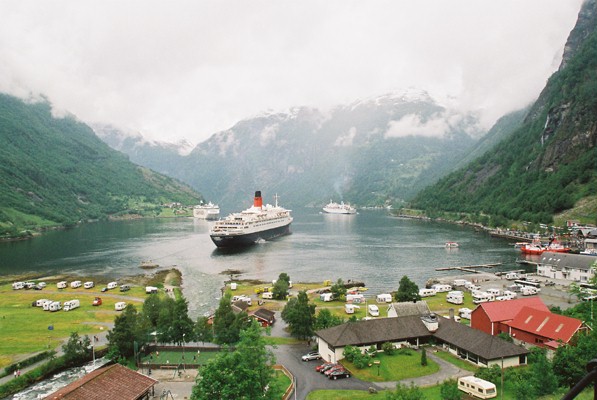
Day 7 saw us leave Geiranger for the Ski resort of Beitostolen, a distance of 129 miles. More hairpin bends on the 63 as we headed up and out of Geiranger, then we took route 15, heading east. This is a magnificent mountain pass where we passed thick snow at the side of the road, whilst the road itself was as dry as a bone, and the temperature wasn't actually too cold, and for a change it wasn't raining. Lots of photo opportunities with the bikes next to huge snow drifts. The alpine scenery gives way as the 15 drops in altitude and runs parallel to Lake Otta before hitting the tourist venue which is Lom. The main focus of Lom is the 1,000 year old wooden Stave church, built by the Vikings which is well worth a look and just at the point the derriere needs a break. Continuing along the 15, we then took route 51, heading south towards our destination of Beitostolen. As soon as we joined the 51, the road started heading up hill, and just kept going skywards, the temperature dramatically dropping with it. The 51 is a high mountain pass and the snow markers at the side of the road loom well above you. There was little traffic on this road, nothing for miles around, the rain turned to heavy snow, it was bitterly cold, and we were running quite low on petrol. This most definitely wasn't the time or place to run out of juice. Wishing that we had filled up at Lom, which by now was well beyond the point of no return, we battled through the snow, hoping to make the hotel before we ran out of petrol. Fortunately we did, arriving at our destination with about 20 miles to spare. Being a Ski resort, Beitostolen has numerous hotels, shops, restaurants and most importantly, a petrol station.
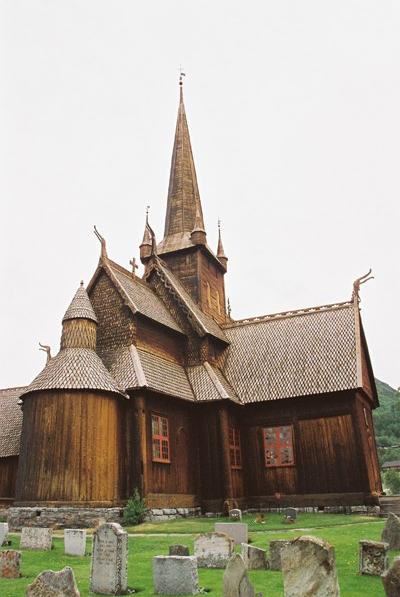
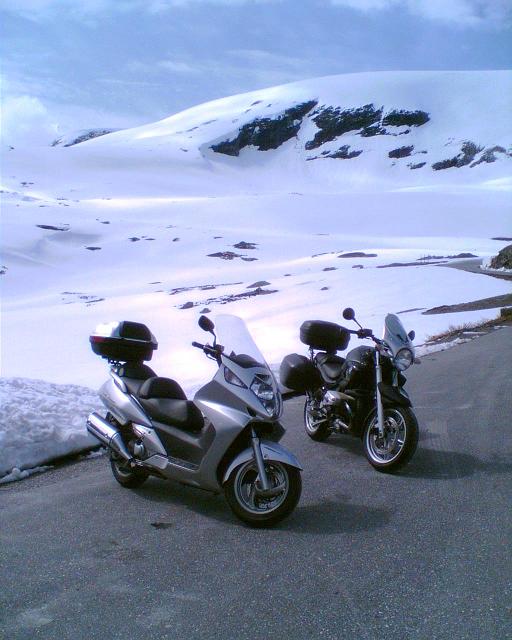
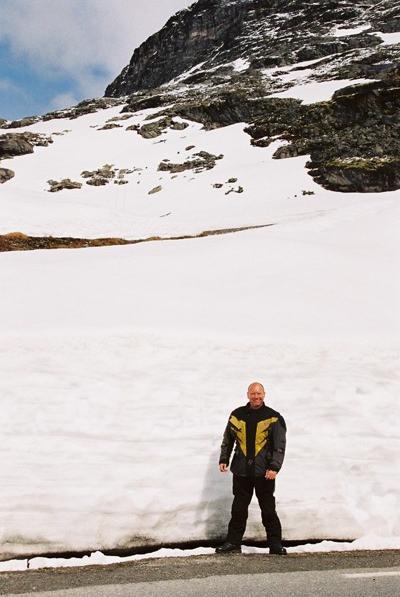
The following morning Justine took a gamble on not wearing waterproofs and managed a mere 5.8 miles of dry riding before having to stop and drag on the trousers in the first layby, receiving sympathetic looks from passing motorists. We continued south along the 51 through yet more stunning scenery, before picking up the E16 for a short distance, then rejoining the 51 towards Gol. Bypassing Gol, we took route 7 to our destination, Geilo, another ski resort. Only 85 miles from Beitostolen but another highly memorable and scenic ride. Rain accompanied most of the journey except for the final five miles where the heavens absolutely opened and it hail stoned like there was no tomorrow. Hailstones really sting your face when you wear an open face helmet. Walking into hotel reception, leaving puddles everywhere, the receptionist mentioned that prior to this week, they have had lovely weather for the last few weeks, by this time we were finding it hard to smile politely at this news but no longer felt guilty about dripping all over their brand new carpet. Geilo is on the Oslo to Bergen railway line which is renowned as being a particularly scenic railway journey and was supposed to have a funicular railway somewhere but we couldn’t find it.
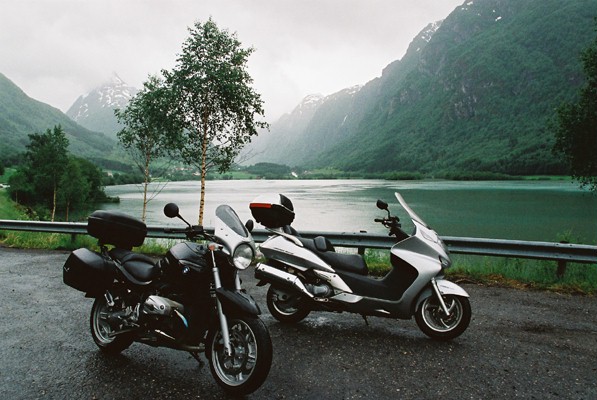
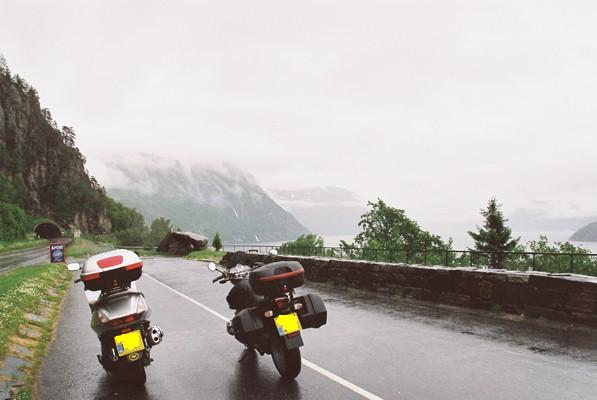
Day 9 we were heading back to Bergen. We backtracked on route 7 to Hagafoss, so we could take the route 50, unsuitable for caravans and with huge signs stating whether it was open that day, so we knew in advance it was going to be a good road. I'm pleased to be able to say that it didn't disappoint for scenery but in some sections was a poor surface with huge ridges in which made life interesting. The road passed through some lovely villages with more wooden churches, before heading up into the stunning Hallingskarvet mountain range. Photo opportunity at the partially frozen Lake Strandavatnet before passing through the first of many tunnels cutting through the mountains, the longest of which being over 5 miles long. It is also interesting when you come across a hairpin bend in a tunnel. Route 50 gives way to the E16, and another tunnel with a hairpin bend, as it makes it's way towards Voss. Voss was packed with hundreds of mums and dads watching the dozens of junior league football matches so our planned stop was changed as not much interested in football or kids we decided to push on. From Voss, we continued on the E16, through many more tunnels and fjords, heading towards Bergen. This route is very popular with Norwegian bikers, and being a sunny Sunday, they were out in force. We passed through the Aurland valley which ( possibly due to the sunshine) was beautiful, the Norwegians must have too many beautiful places as there were no stopping points for photos along the route and many parts of the road are single lane. From the E16, we picked up the 580 at Arna, skirting Bergen city centre, en route to the airport where we stayed on the first night.
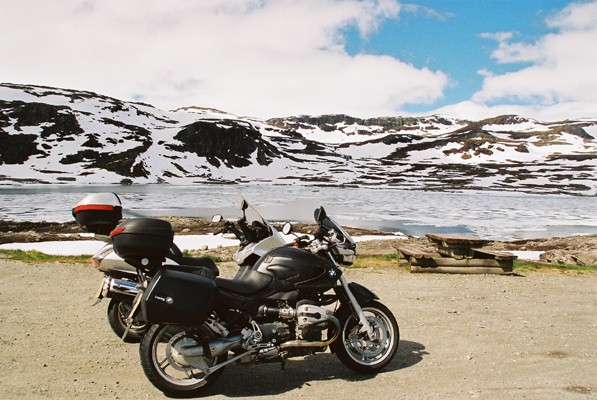
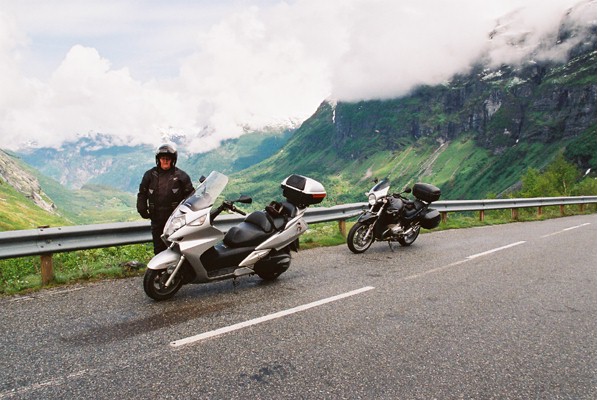
Day 10 we picked up the ferry at Bergen for the 10:00 sailing to Newcastle, arriving the following day at 13:30. Got chatting on the return to a bike group from Glasgow only to find we had all been at the Edinburgh MAG rally the weekend before, so with the rally sunny Saturday followed by a day on the ferry in the sun we at least came back looking we had been away and not rusty. We had thought we had found a great way to tie down the bikes for the return trip but once docked in Newcastle found the crew didn’t agree and there were 2 more straps on than when we left them.
The route we took is fairly typical and everyone we spoke to on the ferry had done a similar route to take in the Fjords and Mountains in this stunning region. Funnily enough though, we didn't see a single British registered bike the whole time we were touring the region.
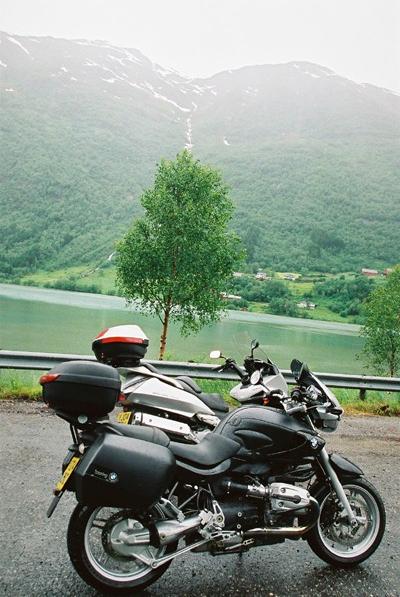
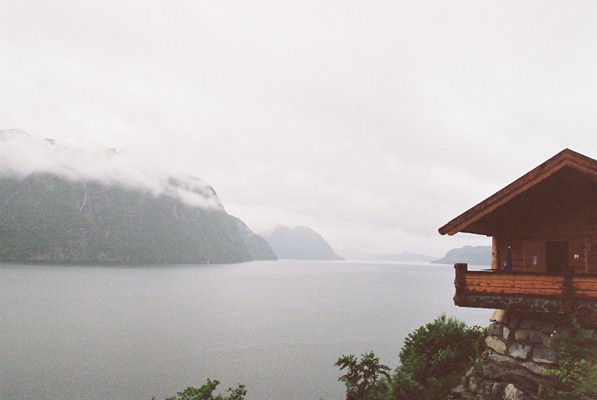
Norway is an absolute bike touring mecca and the Fjords and Mountain scenery is simply breathtaking. Everywhere you look, the views are stunning, the roads are generally in excellent condition, traffic is light, apart from in the towns and cities, and everyone is very biker friendly. Several tourist information sources on the internet explained that the Norwegians love bikers, especially those touring, as they display the same Viking spirit, and there is probably a lot of truth in that. Although we stopped in Hotels (and were very glad of the drying facilities afforded), camp sites are literally everywhere and in stunning locations. Also plentiful are wooden lodges, many of which are rather luxurious.
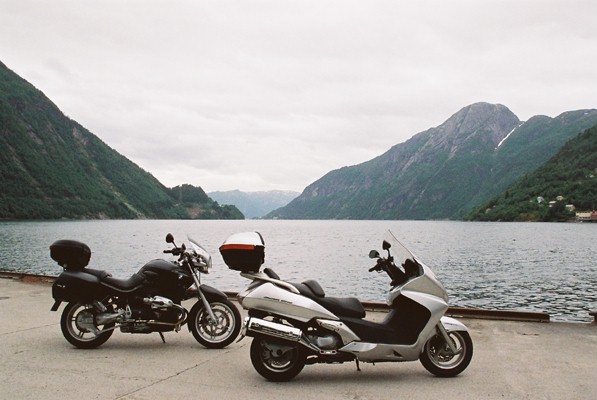
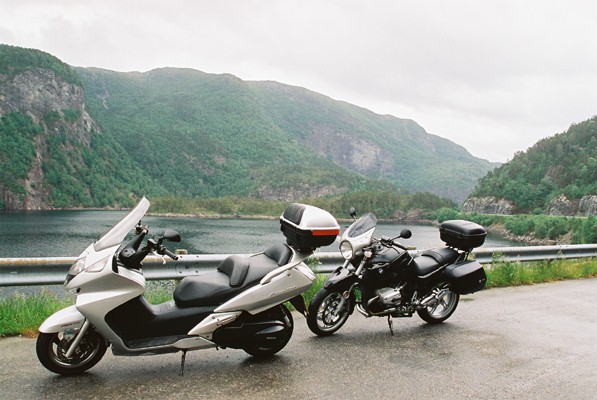
Any downsides? Unfortunately, a few. Norway is incredibly expensive. Food is generally at least twice the price of the UK and the cheapest beer starts at £5 for half a litre. Petrol probably was a lot more expensive but with the way it has been going up in the UK, it is now fairly comparable and at least there were plenty of petrol stations (so long as you remember to fill up at them). The weather is somewhat changeable, it rains a lot and it can, and does snow, even in the height of summer. However, the worst downside is that the twice weekly DFDS ferry link between Newcastle and Bergen stops at the end of August, as the route is apparently uneconomic to run. This is the only ferry from the UK mainland to Norway so the only options to take your own bike there in the future will be a ferry from the Shetland Islands (and a ferry to get there), or, a ferry to Sweden or Denmark, and an awfully long ride from there. Fingers crossed that someone else takes over the route.
Steve & Justine Travis
June 2008